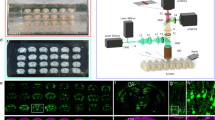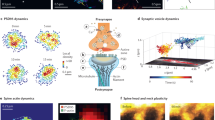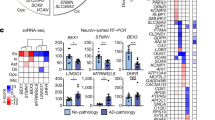Abstract
Postmortem studies of synapses in human brain are problematic because of the axial resolution limit of light microscopy and the difficulty in preserving and analyzing ultrastructure with electron microscopy (EM). Array tomography (AT) overcomes these problems by embedding autopsy tissue in resin and cutting ribbons of ultrathin serial sections. Ribbons are imaged with immunofluorescence, allowing high-throughput imaging of tens of thousands of synapses to assess synapse density and protein composition. The protocol takes ∼3 d per case, excluding image analysis, which is done at the end of the study. Parallel processing for transmission electron microscopy (TEM) using a protocol modified to preserve the structure in human samples allows complementary ultrastructural studies. Incorporation of AT and TEM into brain banking is a potent way of phenotyping synapses in well-characterized clinical cohorts in order to develop clinicopathological correlations at the synapse level. This will be important for research in neurodegenerative disease, developmental disease and psychiatric illness.
This is a preview of subscription content, access via your institution
Access options
Subscribe to this journal
Receive 12 print issues and online access
$259.00 per year
only $21.58 per issue
Buy this article
- Purchase on Springer Link
- Instant access to full article PDF
Prices may be subject to local taxes which are calculated during checkout








Similar content being viewed by others
References
Morrison, J.H. & Baxter, M.G. The ageing cortical synapse: hallmarks and implications for cognitive decline. Nat. Rev. Neurosci. 13, 240–250 (2012).
Koffie, R.M., Hyman, B.T. & Spires-Jones, T.L. Alzheimer′s disease: synapses gone cold. Mol. Neurodegener. 6, 63 (2011).
Mayhew, T.M. How to count synapses unbiasedly and efficiently at the ultrastructural level: proposal for a standard sampling and counting protocol. J. Neurocytol. 25, 793–804 (1996).
Mayhew, T.M., Muhlfeld, C., Vanhecke, D. & Ochs, M. A review of recent methods for efficiently quantifying immunogold and other nanoparticles using TEM sections through cells, tissues and organs. Ann. Anat. 191, 153–170 (2009).
Scheff, S.W., Price, D.A. & Sparks, D.L. Quantitative assessment of possible age-related change in synaptic numbers in the human frontal cortex. Neurobiol. Aging 22, 355–365 (2001).
Pawley, J.B. Handbook of Biological Confocal Microscopy (Springer, 2006).
Holtmaat, A. et al. Long-term, high-resolution imaging in the mouse neocortex through a chronic cranial window. Nat. Protoc. 4, 1128–1144 (2009).
Kuchibhotla, K.V. et al. Aβ plaques lead to aberrant regulation of calcium homeostasis in vivo resulting in structural and functional disruption of neuronal networks. Neuron 59, 214–225 (2008).
Wakabayashi, K., Honer, W. & Masliah, E. Synapse alterations in the hippocampal-entorhinal formation in Alzheimer′s disease with and without Lewy body disease. Brain Res. 667, 24–32 (1994).
Moore, D. et al. Cortical and subcortical neurodegeneration is associated with HIV neurocognitive impairment. AIDS 20, 879–887 (2006).
DeKosky, S., Scheff, S. & Styren, S. Structural correlates of cognition in dementia: quantification and assessment of synapse change. Neurodegeneration 5, 417–421 (1996).
Masliah, E., Terry, R., Alford, M., DeTeresa, R. & Hansen, L. Cortical and subcortical patterns of synaptophysinlike immunoreactivity in Alzheimer′s disease. Am. J. Pathol. 138, 235–246 (1991).
Clare, R., King, V., Wirenfeldt, M. & Vinters, H. Synapse loss in dementias. J. Neurosci. Res. 88, 2083–2090 (2010).
Tai, H.-C. et al. The synaptic accumulation of hyperphosphorylated tau oligomers in Alzheimer disease is associated with dysfunction of the ubiquitin-proteasome system. Am. J. Pathol. 181, 1426–1435 (2012).
Micheva, K.D. & Smith, S.J. Array tomography: a new tool for imaging the molecular architecture and ultrastructure of neural circuits. Neuron 55, 25–36 (2007).
Micheva, K.D., Busse, B., Weiler, N.C., O′Rourke, N. & Smith, S.J. Single-synapse analysis of a diverse synapse population: proteomic imaging methods and markers. Neuron 68, 639–653 (2010).
Koffie, R.M. et al. Oligomeric amyloid-β associates with postsynaptic densities and correlates with excitatory synapse loss near senile plaques. Proc. Natl. Acad. Sci. USA 106, 4012–4017 (2009).
Koffie, R.M. et al. Apolipoprotein E4 effects in Alzheimer′s disease are mediated by synaptotoxic oligomeric amyloid-β. Brain 135, 2155–2168 (2012).
Kopeikina, K.J. et al. Tau accumulation causes mitochondrial distribution deficits in neurons in a mouse model of tauopathy and in human AD brain. Am. J. Pathol. 179, 2071–2082 (2011).
Soiza-Reilly, M. & Commons, K.G. Quantitative analysis of glutamatergic innervation of the mouse dorsal raphe nucleus using array tomography. J. Comp. Neurol. 519, 3802–3814 (2011).
Nanguneri, S., Flottmann, B., Horstmann, H., Heilemann, M. & Kuner, T. Three-dimensional, tomographic super-resolution fluorescence imaging of serially sectioned thick samples. PLoS ONE 7, e38098 (2012).
Kopeikina, K.J. et al. Synaptic alterations in the rTg4510 mouse model of tauopathy. J. Comp. Neurol. 521, 1334–1353 (2013).
de Calignon, A. et al. Propagation of tau pathology in a model of early Alzheimer′s disease. Neuron 73, 685–697 (2012).
Lacey, C.J., Bryant, A., Brill, J. & Huguenard, J.R. Enhanced NMDA receptor-dependent thalamic excitation and network oscillations in stargazer mice. J. Neurosci. 32, 11067–11081 (2012).
Oberti, D., Kirschmann, M.A. & Hahnloser, R.H. Projection neuron circuits resolved using correlative array tomography. Front Neurosci. 5, 50 (2011).
Oberti, D., Kirschmann, M.A. & Hahnloser, R.H. Correlative microscopy of densely labeled projection neurons using neural tracers. Front Neuroanat. 4, 24 (2010).
Robles, E., Smith, S.J. & Baier, H. Characterization of genetically targeted neuron types in the zebrafish optic tectum. Front Neural Circuits 5, 1 (2011).
Saatchi, S. et al. Three-dimensional microstructural changes in murine abdominal aortic aneurysms quantified using immunofluorescent array tomography. J. Histochem. Cytochem. 60, 97–109 (2012).
Winkler, M. et al. High resolution three-dimensional reconstruction of the collagenous matrix of the human optic nerve head. Brain Res. Bull. 81, 339–348 (2010).
Vonsattel, J. et al. An improved approach to prepare human brains for research. J. Neuropathol. Exp. Neurol. 54, 42–56 (1995).
Wright, A.K., Wishart, T.M., Ingham, C.A. & Gillingwater, T.H. Synaptic protection in the brain of WldS mice occurs independently of age but is sensitive to gene-dose. PLoS ONE 5, e15108 (2010).
Freeberg, T.M. & Lucas, J.R. Pseudoreplication is (still) a problem. J. Comp. Psychol. 123, 450–451 (2009).
Rudinskiy, N. et al. Orchestrated experience-driven Arc responses are disrupted in a mouse model of Alzheimer′s disease. Nat. Neurosci. 15, 1422–1429 (2012).
Thevenaz, P., Ruttimann, U.E. & Unser, M. A pyramid approach to subpixel registration based on intensity. IEEE Trans Image Process 7, 27–41 (1998).
Koch, S. et al. Morphologic and functional correlates of synaptic pathology in the cathepsin D knockout mouse model of congenital neuronal ceroid lipofuscinosis. J. Neuropathol. Exp. Neurol. 70, 1089–1096 (2011).
Gillingwater, T. et al. Delayed synaptic degeneration in the CNS of WldS mice after cortical lesion. Brain 129, 1546–1556 (2006).
Acknowledgements
We thank the patients and their families for their generous donations. We also thank K. Micheva and S. Smith for training us in the AT technique; D. Selkoe (Harvard Medical School), V. Lee (University of Pennsylvania) and D. Walsh (Harvard Medical School) for antibodies; and K. Kuchibhotla and S. Raymond for MATLAB programming. Harvard Catalyst supplied biostatistical support. This work was supported by US National Institutes of Health (NIH) grants R00AG033670 (T.L.S.-J., K.R.K.), T32AG000277 (K.J.K., B.T.H.), P50AG05134 (B.T.H., A.S.-P., M.P.F.); Alzheimer's Research UK (A.M.P.), the Sylvia Aitken Charitable Trust (C.S., A.K.W., M.E.B., T.H.B., S.A., T.H.G.) and the Medical Research Council UK G110616 (C.S.).
Author information
Authors and Affiliations
Contributions
K.R.K., T.L.S.-J., A.S.-P., A.M.P., R.K. and K.J.K. performed AT experiments. C.S. and M.P.F. consulted on neuropathology. K.R.K. C.S., D.M., A.S.-P., R.K. and T.L.S.-J. collected human brain tissue. A.K.W., M.E.B., T.H.B., S.A. and T.H.G. designed and performed electron microscopy experiments. K.R.K., A.S.-P., A.M.P., K.J.K., C.S., T.H.G., B.T.H. and T.L.S.-J. discussed the data and prepared the manuscript.
Corresponding author
Ethics declarations
Competing interests
The authors declare no competing financial interests.
Supplementary information
Supplementary Figure 1
Example of stripping and re-probing array ribbons. (PDF 1719 kb)
Supplementary Table 1
Characteristics of human subjects used. (PDF 489 kb)
Supplementary Video 1
Demonstration of making AT blocks from fresh tissue. (MOV 10955 kb)
Supplementary Methods
Instructions for automated imaging of AT ribbons with AxioVision macros. (PDF 527 kb)
Supplementary Data 1
ImageJ macro examples for AT analysis. (PDF 512 kb)
Supplementary Data 2
MATLAB script for colocalization analysis of AT images. (PDF 489 kb)
Rights and permissions
About this article
Cite this article
Kay, K., Smith, C., Wright, A. et al. Studying synapses in human brain with array tomography and electron microscopy. Nat Protoc 8, 1366–1380 (2013). https://doi.org/10.1038/nprot.2013.078
Published:
Issue Date:
DOI: https://doi.org/10.1038/nprot.2013.078
This article is cited by
-
Altered amyloid-β structure markedly reduces gliosis in the brain of mice harboring the Uppsala APP deletion
Acta Neuropathologica Communications (2024)
-
p-tau Ser356 is associated with Alzheimer’s disease pathology and is lowered in brain slice cultures using the NUAK inhibitor WZ4003
Acta Neuropathologica (2024)
-
CLARITY increases sensitivity and specificity of fluorescence immunostaining in long-term archived human brain tissue
BMC Biology (2023)
-
A method for ultrafast tissue clearing that preserves fluorescence for multimodal and longitudinal brain imaging
BMC Biology (2022)
-
Synaptic proteomics reveal distinct molecular signatures of cognitive change and C9ORF72 repeat expansion in the human ALS cortex
Acta Neuropathologica Communications (2022)
Comments
By submitting a comment you agree to abide by our Terms and Community Guidelines. If you find something abusive or that does not comply with our terms or guidelines please flag it as inappropriate.



